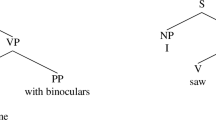Abstract
In this paper we introduce and compare four different syntactic methods for generating sequent calculi for the main systems of modal logic: the multiple sequents method, the higher-arity sequents method, the tree-hypersequents method and the display method. More precisely we show how the first three methods can all be translated in the fourth one. This result sheds new light on these generalisations of the sequent calculus and raises issues that will be examined in the last section.
Similar content being viewed by others
References
Avron A. (1996) The method of hypersequents in the proof theory of propositional non-classical logic. In: Hodges W., Hyland M., Steinhorn C., Strauss J. (eds) Logic: From foundations to applications. Oxford University Press, Oxford, pp 1–32
Belnap N.D. (1982) Display logic. Journal of Philosophical Logic 11: 375–417
Belnap N.D. (1990) Linear logic displayed. Notre Dame Journal of Formal Logic 31: 14–25
Belnap N.D. (1996) The display problem. In: Wansing H. (eds) Proof theory of modal logic. Dordrecht, Kluwer Academic Publisher
Blamey S., Humberstone L. (1991) A perspective on modal sequent logic. Publications of the Research Institute for Mathematical Sciences, Kyoto University 27: 763–782
Brunnler K. (2006) Deep sequent systems for modal logic. Advances in Modal Logic AiML 6: 107–119
Curry H.B. (1952) The elimination theorem when modality is present. Journal of Symbolic Logic 17: 249–265
Fitting M. (1983) Proof methods for modal and intuitionistic logics. Reidel, Dordrecht
Goré R. (1998) Substructural logics on display. Logic Journal of the IGPL 6: 669–694
Goré R., Tiu A. (2007) Classical Modal Display Logic in the Calculus of Structures and Minimal Cut-free Deep Inference Calculi for S5. Journal of Logic and Computation 17: 767–794
Gottwald S. (1989) Mehrwertige logik. Akademie-Verlag, Berlin
Guglielmi A. (2007) A system of interaction and structure. ACM Transactions on computational Logic 8: 1–64
Hasuo I., Kashima R. (2003) Kripke completeness of first-order constructive logics with strong negation. Logic Journal of the IGPL 11: 615–646
Indrezejczak A. (1997) Generalised sequent calculus for propositional modal logics. Logica Trianguli 1: 15–31
Ishigaki, R., & Kikuchi, K. (2007). Tree-sequent method for subintuitionistic predicate logics. In N. Olivetti (Ed.), Proceedings of the 16th International Conference on Automated Reasoning with Analytic Tableaux and Related Methods, LNAI (Vol. 4548, pp. 149–164).
Kashima R. (1994) Cut-free sequent calculi for some tense logics. Studia Logica 53: 119–135
Kracht M. (1996) Power and weakness of the modal display calculus. In: Wansing H. (eds) Proof theory of modal logic. Kluwer Academic Publishers, Dordrecht
Mints G. (1997) Indexed systems of sequents and cut-elimination. Journal of Philosophical Logic 26: 671–696
Poggiolesi, F. (2008). Sequent calculi modal logic (pp. 1–224). PhD Thesis, University of Florence, Department of Philosophy.
Poggiolesi, F. (2009). The method of tree-hypersequent for modal propositional logic. In D. Makinson, J. Malinowski, & H. Wansing (Eds.), Trends in logic: Towards mathematical philosophy (pp. 9–30). Springer.
Restall G. (1998) Displaying and deciding substructural logics. I. Logics with contraposition. Journal of Philosophical Logic 27: 179–216
Rousseau G. (1967) Sequents in many-valued logic. I. Fundamenta Mathematicae 60: 23–131
Sato M. (1977) A study of kripke-type models for some modal logics by gentzen’s sequential method. Publications of the Research Institute for Mathematical Sciences, Kyoto University 13: 381–468
Schroeter M. (1955) Methoden zur axiomatisierung beliebiger aussagen- und praedikatenkalkuele. Zeitschrift fuer mathematische Logik und Grundlagen der Mathematik 1: 214–251
Stewart, C., & Stouppa, P. (2005). A systematic proof theory for several modal logics. In R. Schmidt, I. Pratt-Hartman, M. Reynolds, & H.Wansing (Eds.), Advances in modal logic (Vol. 5, pp. 309–333). London: Kings College Publications.
Wansing H. (1994) Sequent systems for normal modal propositional logics. Journal of Logic and Computation 4: 125–142
Wansing H. (1997) Displaying as temporalizing. sequent systems for subintuitionistic logics. In: Hakama S. (eds) Logic, language and computation. Kluwer Academic Publishers, Dordrecht
Wansing H. (1998) Displaying modal logic. Kluwer Academic Publisher, Dordrecht
Wansing, H. (2002). Sequent systems for modal logics. In D. M. Gabbay & F. Guenther (Eds.), Handbook of philosophical logic (Vol. 8, pp. 61–145). Dordrecht: Kluwer Academic Publishers.
Zeman J. (1973) Modal logic. The Lewis-modal systems. Oxford University Press, Oxford
Author information
Authors and Affiliations
Corresponding author
Rights and permissions
About this article
Cite this article
Poggiolesi, F. Display calculi and other modal calculi: a comparison. Synthese 173, 259–279 (2010). https://doi.org/10.1007/s11229-008-9425-4
Received:
Accepted:
Published:
Issue Date:
DOI: https://doi.org/10.1007/s11229-008-9425-4




